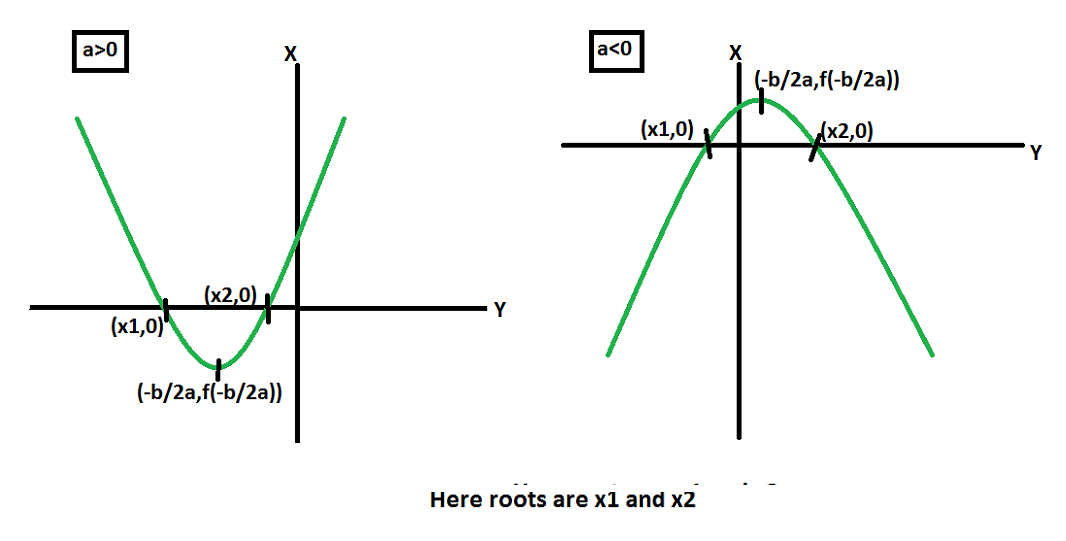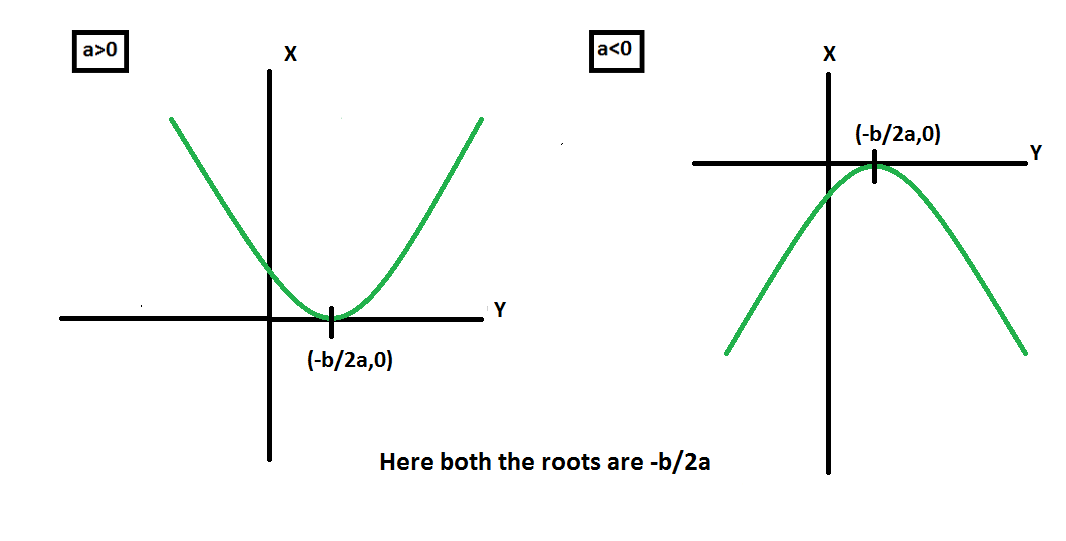二次方程式是多项式为二阶的方程式。二次方程式是ax 2 + bx + c = 0的方程式,其中x是未知的,而a,b,c是已知的实数,并且a不应为零。如果a = 0,则方程将不会保持二次方程,则将变为线性,因为a = 0将消除x 2项。由于二次方程具有最高的二阶,因此该方程具有两个根,或者可以说我们将为二次方程找到两个x值。
如何找到根?
方法1:可以通过Shridharacharaya公式找到二次方程式的根。
x = [-b±√(b 2 – 4ac)] / 2a
示例:矩形的边长由x – 3和x – 5给出,矩形的面积为3 unit 2 。找到矩形的边。
解决方案:
Area of rectangle = length*breadth = (x – 3)(x – 5) = 3
Area = x2 – 8x + 15 = 3
= x2 – 8x + 12 = 0
Discriminant = b2 – 4ac = 64 – (4(1)(12)) = 64 – 48 = 16
x = [-b ± √(b2-4ac)]/2a = [-(-8) ± √16]/2 = (8±4)/2
x = 12/2 or 4/2
x = 2 or 6
When x is 2, sides are x – 3 = 2 – 3 = -1 and x – 5 = 2 – 5 = -3.
Since length of sides cannot be equal therefore x = 2 is not a valid ans.
When x is 6, sides are x – 3 = 6 – 3 = 3 and x – 5= 6 – 5 =1.
Therefore, x = 6 is the valid answer and the sides are 3 and 1.
方法2。另一种方法是分解方法。二次方程式可以认为是两个项的因数。像ax 2 + bx + c = 0可以写成(x – x 1 )(x – x 2 )= 0,其中x 1和x 2是二次方程的根。
脚步:
- 找出两个数字,使得乘积= ac且和= b。
- 然后将x系数写为这两个数字的总和,并将它们除以得到x的两个项。
- 将前两个项作为一个组,将后两个项作为一个组。
- 从这些中取公因数,并在取公因数并重新排列方程后,将两个表达式等于0,得到了根。
例子:设二次方程x 2 + 3x = 18
x2 + 3x – 18 = 0
Step:
1. 6 and -3 are the numbers whose sum is equal to b and product is equal ac.
2. x2 + (6-3)x – 18 = x2 + 6x -3x – 18 =0
3. x(x + 6) – x(x + 6) = 0
4. taking (x + 6) as common.
(x + 6)(x – 3) = 0
x = -6 or x = 3
在分解方法中,不必总是容易找到这两个数字(尤其是在根是虚数或无理数的情况下),因此最好使用二次公式。
根的性质
根的性质取决于二次方程的判别式。二次方程的判别式由b 2 – 4ac给出。之所以这样,是因为在二次方程式中存在判别式的平方根。
根1:如果b 2 – 4ac> 0,则根是真实且不同的。由于判别式> 0,因此它的平方根将不会是虚的。它有两种情况。
- 如果b 2 – 4ac是一个完美的平方,则根是有理的。由于判别式是一个完美的平方,因此我们将有一个整数作为判别式的平方根。因此,根是有理数。
示例:令二次方程为x 2 -5x + 6 = 0。
Then the discriminant of the given equation is b2 – 4ac=(-5)2 – 4*1*6 = 25-24 = 1
According to Shridharacharaya formula
x = [-b±√(b2-4ac)]/2a = x = [-(-5) ± √1]/2
x1 = [-(-5) + √1]/2 = 6/2 = 3
x2 = [-(-5) – √1]/2 = 4/2 = 2
Therefore, the roots are 3,2. Both are rational and different.
- 如果B 2 – 4AC不是一个完美的正方形然后判别的平方根是不合理的,因此根是不合理的,发生在对。
示例:令二次方程为x 2 -7x + 8 = 0。
Then the discriminant of the given equation is
b2 – 4ac=(-7)2 – 4*1*8 = 49-32 = 17
According to Shridharacharaya formula
x = [-b±√(b2-4ac)]/2a = x = [-(-7) ± √17]/2
x1 = [-(-7) + √17]/2 = [7 + √17]/2
x2 = [-(-7) – √17]/2 = [7 – √17]/2
Therefore, the roots are [7 + √17]/2,[7 – √17]/2. Both are irrational and in pairs.
根2:如果b 2 – 4ac = 0,则根是真实且相等的。
示例:令二次方程为3x 2 -6x + 3 = 0。
Then the discriminant of the given equation is
b2 – 4ac=(-6)2 – 4*3*3 = 36 – 36 = 0
According to Shridharacharaya formula
x = [-b±√(b2-4ac)]/2a = x = [-(-6) ± √0]/[(2)(3)]
x1 = [-(-6) + √0]/2 = 6/6 = 1
x2 = [-(-6) – √0]/2 = 6/6 = 1
Therefore, the roots are 1,1. Both are real and equal.
根3:如果b 2 – 4ac <0根是假想的,或者您可以说复数根。这是虚构的,因为平方根下的项为负。这些复杂的根将始终成对出现,即两个根彼此共轭。
示例:令二次方程为x 2 + 6x + 11 = 0。
Then the discriminant of the given equation is
b2 – 4ac=(6)2 – 4*1*11 = 36-44 = -8
According to Shridharacharaya formula
x = [-b±√(b2-4ac)]/2a = x = [-(6) ± √(-8)]/2
x1 = [-(6) + √(-8)]/2 = [-6 + √8i]/2 = 2[-3 + √2i]/2 = -3 + √2i
x2 = [-(6) – √(-8)]/2 = [-6 – √8i]/2 = 2[-3 – √2i]/2 = -3 – √2i
Therefore, the roots are 3,2. Both are imaginary and conjugate of each other(in pair).
根图
在x = -b / 2a处发现二次函数的最大值/最小值
证明:
当d(f(x))/ dx = 0时,我们得到最大值或最小值。
关于微分二次函数f(x)= ax 2 + bx + c。
我们得到
2ax + b = 0
x = -b / 2a
x是最大值(a <0)或最小值(a> 0)。
1.当b 2 – 4ac> 0时

2.当b 2 – 4ac = 0时

3.当b 2 – 4ac <0时

二次方程词问题
问题1.三角形的高度比底边小4厘米。三角形的面积为30 cm 2 。找到三角形的高度和底边。
解决方案:
Let the base of triangle be x cm then height is x-4 cm
Area of triangle = 1/2*height*base = 1/2*(x)(x – 4)=30
Area = x2 – 4x = 30*2
= x2 – 4x = 60
= x2 – 4x – 60 = 0
Discriminant = (-4)2 – 4(1)(-60) = 16+240 = 256
x = [-b±√(b2 – 4ac)]/2a = [-(-4)±√256]/2 = (4±16)/2
x = 20/2 or -12/2
x = 10 or -6
As side cannot be negative, therefore -6 is not correct.
So, when x is 10, base =10 cm and height =x – 4 = 10 – 4 = 6 cm
Therefore, x = 10 is the valid answer and the base and height of the triangle are 10 and 6 respectively.
问题2.盒子的体积是600英寸2 。盒子的长度比宽度小2英寸。盒子的高度是5英寸。找到盒子的尺寸。
解决方案:
Let the width of box be x inches then length = x – 2 inches.
Volume of box =Length* Width *Height = (x-2)(x)5= 600
x2 – 2x = 120 => x2 – 2x -120 = 0
x2 + 10x – 12x – 120 = 0
x(x + 10) – 12(x + 10)=0
(x – 12)(x + 10)=0
x = 12 or x = -10
As width can not be negative, therefore, -10 is not correct.
When x = 12, width = 12 inches, length = x – 2 = 12 – 2 = 10 inches, height = 5 inches
问题3.从建筑物的顶部扔一个球。其在地下作为时间的函数米以上的高度为h(T)= -4t 2 +24吨+ 3 a)有多少时间达到最大高度,什么是最大高度给定。 b)还找出球击中地面的时间。
解决方案:
a) Since a<0, therefore the time to reach maximum height is = -b/2a. (refer graph part)
t = -24/(2(-4)) = -24/-8
t = 3 sec.
Height = h(t) = -4(3)2 +24(3)+3 = 39 meters.
b) When the ball hits the ground h(t)=0.
-4t2 + 24t + 3 = 0
The discriminant of the given equation is
b2 – 4ac=(24)2 – 4*(-4)*3 = 576 + 48 = 624
According to Shridharacharaya formula
x = [-b±√(b2-4ac)]/2a = x = [-(24) ± √624]/[(2)(-4)]
x1 = [-24 + √624]/-8= 4 [-6 + √39]/-8 = [-6 + √39]/-2 = [6 – √39]/2 = -0.122499 = -0.1225(approx)
x2 = [-24 – √624]/-8= 4 [-6 – √39]/-8 = [-6 – √39]/-2 = [6 + √39]/2 = 6.122499 = 6.1225(approx)
As time can not be negative, therefore, [6 – √39]/2 sec is not correct.
Therefore, the ball hits the ground at [6 + √39]/2 = 6.122499 = 6.1225 sec